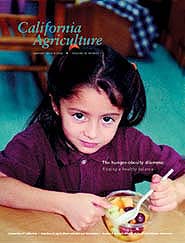All Issues
Letters
Publication Information
California Agriculture 58(2):79-79.
Published April 01, 2004
PDF | Citation | Permissions
Full text
Sell produce locally to fight fat
The January-March 2004 issue, with its focus on hunger and obesity, caught my interest. I grew up in a lower-middle class family. Both of my parents weigh over 200 pounds. My brothers and I would fill up on snack food after school because dinner was usually unpalatable. Lunch in the school cafeteria was the best meal of the day, and my brothers and I rejoiced when our school district started serving breakfast as well.
If any lasting change is to be made, acquiring and eating healthy foods must become convenient. A few examples:
In Pittsburg, Kansas, when the economy began its slump, Wal-Mart, which is the largest grocer in town, started giving local farmers first option on busines. This helped guarantee that the population had enough money to buy the foods they needed.
To better understand how mothers may influence their child's eating habits and weight, the authors studied pairs of low-income Latino mothers and their young children. This mother and daughter enjoying lunch were not study participants.
I recently visited India for the first time, and I noticed that there was a vegetable market just outside my apartment. Vegetable markets in India are a convenient walk — usually within half a mile — from nearly every residential area. Instead of people going to the market, the market goes to the people, even in the middle of winter when temperatures drop as low as 40°F.
Here's an idea. The larger grocers can take a few boxes of a variety of fruits and vegetables to these residential areas where the working poor live, either when they would pass the vendors on the way home or be at home (and able to go to the vendors easily). The vendors sell the produce for an honest profit, and the families get the foods they want.
People are forced into bad eating habits for convenience, but for convenience they will change those habits. The people will have healthier, bettertasting food, and they will feel better. Also, the grocers willing to risk doing business in this new way will reap many benefits. They will enjoy increased sales and cash flow for the mere cost of labor — one person to man the vegetable stand. The grocers who do this will also earn the high opinion of their customers. Imagine the gratitude of a mother who can feed her children foods they really want — oranges, salads and fresh juices — because the grocer does the traveling.
The crucial point is to determine the areas where this service is most needed and the times during which people living in those areas will be free to shop; increasing service would increase the bottom line for grocers.
Michelle Jain
Kansas City, Missouri
Interesting for nonfarmer
It's so rare to find an agriculture publication of any kind that can be read with interest by a nonfarmer. What I like about California Agriculture is that it gets me beyond a view of agriculture as just a production process with inputs and outputs. It shows me many of the ways that agriculture fits interdependently with the earthly (land/water/air) resources that sustain it and the people who live on that earth.
What got me really thinking in the January-March 2004 issue was the package on the connections between food insecurity and obesity. This was something I have been thinking about since I taught junior-high kids in Bakersfield 25 years ago and watched how they acted. I am really glad this research was done, because I think it speaks to a key public-health issue. But I am especially grateful that your team of authors and editors managed to explain the research in ways that I could understand and that stayed true to the complexity of the issue. Maybe it was just that sweet picture of a kid eating fruit salad on the cover. If only I could get my 6-year-old to eat her veggies!
That was just one of the articles in the last issue that put agriculture in a larger social context — the people connection that includes labor, nutrition, immigration, economics, health … you name it. So it's not just the great writing and graphics that make California Agriculture interesting; it's the fact that you are telling me about agriculture in a way that really matters to people.
WHAT DO YOU THINK? The editorial staff of California Agriculture welcomes your letters, comments and suggestions. Please write to us at calag@ucop.edu or 1111 Franklin St., 6th fl., Oakland, CA 94607. Include your full name and address. Letters may be edited for space and clarity.
Joseph A. Davis, Writer-Editor
Bethesda, Maryland





